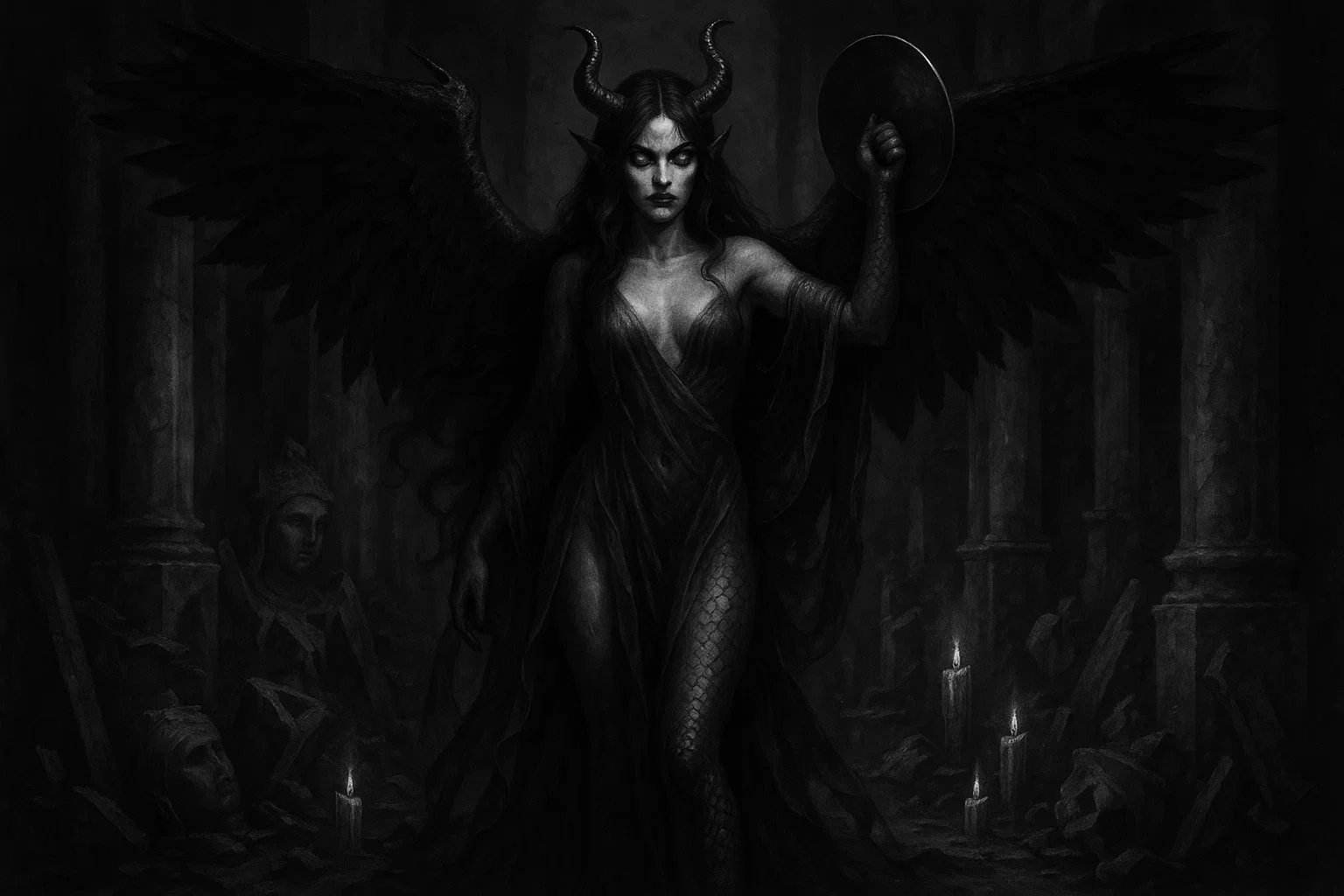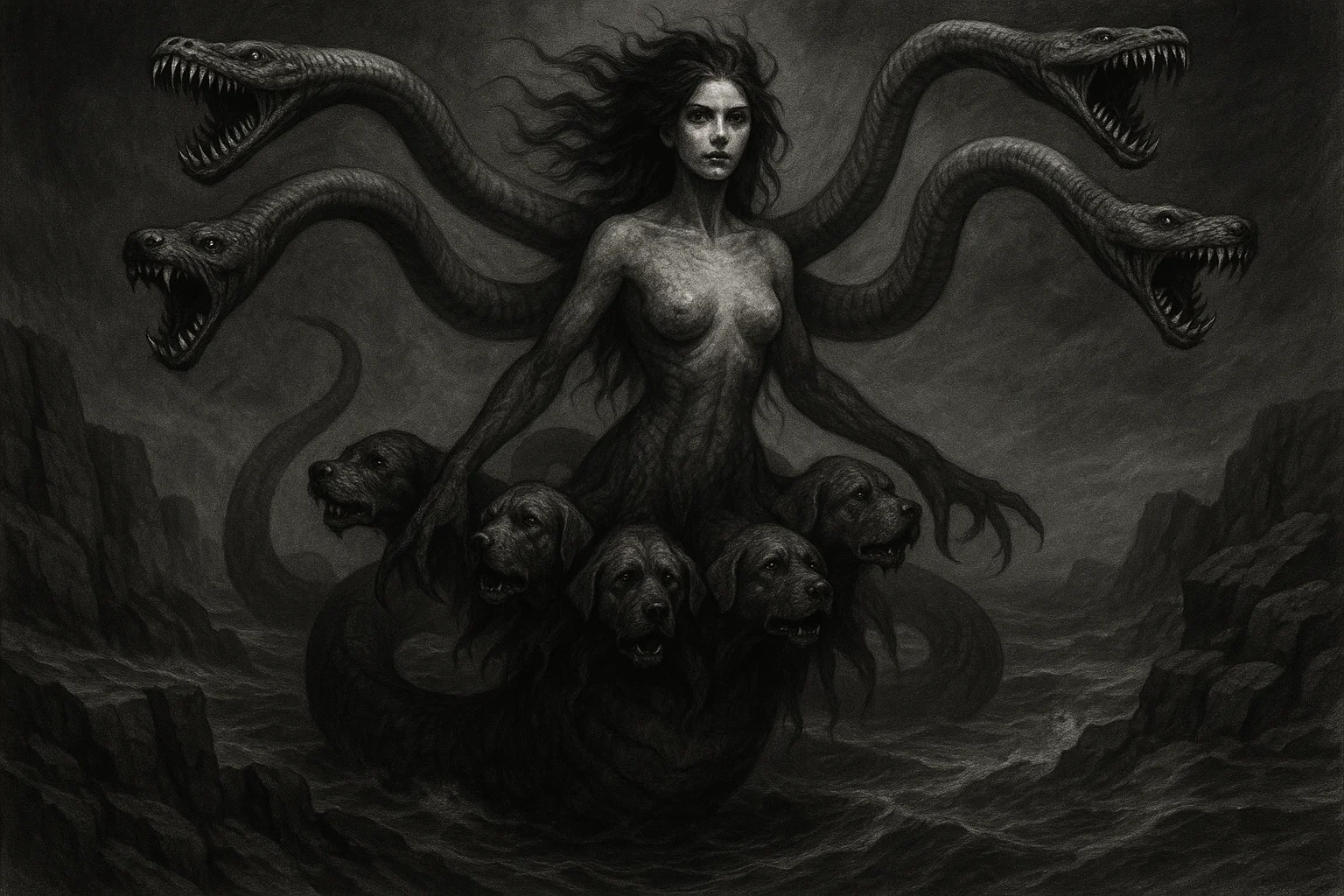What shadowy force could lure celestial angels from their heavenly perches, only to plunge them into eternal damnation? How does a single whisper in the night birth legions of plagues that torment humanity’s most vulnerable? And why does the name Naamah, echoing through ancient scrolls, evoke both irresistible allure and profound terror?
In the labyrinthine depths of Jewish mysticism and demonic lore, Naamah stands as a quintessential succubus, a demoness whose pleasant facade masks an abyss of corruption and ruin. As a pivotal figure in the Zohar’s esoteric teachings, she embodies the perilous intersection of desire and destruction, her influence seeping into dreams, idolatry, and the very fabric of infernal hierarchies.
Delving into Naamah‘s enigma raises more questions than answers: Could her melodies truly ensnare the divine, or do they merely amplify the hidden vices within us all? What forgotten origins link her to primordial seas and cursed bloodlines, and how has her legacy twisted through centuries of myth?
Summary
Key Information
| Category | Details |
|---|---|
| Name | Naamah, Na’amah, Nahema, Nahemoth, Naamath, Maamah, Nehema, Nahama |
| Title | Mother of Demons, Mother of Divination, The Charmer, Angel of Prostitution, Queen of the Eastern Quarter (Damascus), Princess of Hell, Daughter of Darkness, Devourer of Men’s Dreams, Hand of Lilith, Seductress of Angels, Ruler of Plagues, Queen of Succubi, Harbinger of Idolatry, Sovereign of Nahemoth |
| Gender | Female |
| Role | Succubus demoness specializing in nocturnal seduction, corruption of angels and mortals, patron of forbidden music and divination leading to damnation, generator of demonic progeny and plagues, ruler over ecstatic but ruinous intersections of lust, spiritual deception, and idolatrous rites, instigator of epilepsy and infant afflictions |
| Hierarchy | One of the four demon queens of Hell alongside Lilith, Agrat bat Mahlat, and Eisheth Zenunim; high-ranking governor in the Qliphoth’s Nahemoth (shadowed Malkuth); consort to Samael in the Sitra Achra; commands lesser succubi and plague spirits in the infernal court |
| Servitors | Nashiym (Plagues of Mankind, her spectral demonic offspring); lesser succubi and incubi under her sway; spirits born from nocturnal emissions; demon kings like Afrira and Qastimon who pursue but indirectly serve through failed conquests; various unnamed fiends of divination and seduction |
| Superior Demon | Samael (primary consort and archangel of venom); Satan (in some syncretic views as overarching prince); Lilith (as elder sister and occasional overlord in the queens’ alliance) |
| Powers | Nocturnal dream invasion for essence extraction and demon conception; angelic corruption via irresistible allure; infliction of epilepsy and child plagues; musical enchantment fostering idolatry; shapeshifting for evasion and temptation; generation of infernal legions from mortal desires; darkness manipulation; mind control through seductive whispers; death inducement via prolonged energy drain; prophetic divination twisted to mislead and corrupt |
| Appearance | Ethereal beauty with pale luminescent skin, flowing ebony hair alive with shadows, and hypnotic eyes of deep sapphire or emerald; bat-like or obsidian wings; serpentine lower body in monstrous forms; subtle crescent horns; can appear as a seductive mortal woman, aquatic siren, or terrifying daughter of darkness with jagged fangs and claw-like hands |
| Etymology | Derived from Hebrew נַעֲמָה (Naʿămā), meaning “pleasant” or “delightful,” with roots in נָעַם (na’am) implying grace that deceives; interpreted as idolatrous songs “pleasing” to false gods; linked to pre-flood sinfulness in Cain’s line |
| Associated Figures | Lilith (sister and co-conspirator in seductions); Agrat bat Mahlat and Eisheth Zenunim (fellow demon queens); Samael (consort); Adam (nocturnal victim); Azazel, Uzza, Azael (corrupted angels); Asmodeus (demonic son); Shamdon (angelic mate for Asmodeus’s birth); Noah (conflicting tales of kinship); Cain and Lamech (ancestral bloodline); Afrira and Qastimon (pursuing demon kings) |
| Weaknesses | Divine invocations using holy names like YHVH or Adonai; protective amulets with angelic seals; iron implements echoing her brother Tubal-Cain’s forges; waning moon phases diminishing her nocturnal strength; exorcisms with sacred psalms or dissonant holy music; barriers of salt and rue; opposing angels’ interventions |
| Opposing Angel/Saint | Michael (wielder of justice against corruption); Raphael (healer of plagues and dreams); Sandalphon (guardian of holy Malkuth against Qliphothic inversion); Gabriel (messenger thwarting deceptive divinations) |
| Equipment/Tools | Cymbals and lyres for enchanting melodies; dream veils woven from shadows; serpentine whips symbolizing entrapment; incense burners for ritual smokes; vessels of seawater or desert sands; copper mirrors reflecting twisted desires; sigils etched in crimson for summoning legions |
| Pantheon | Jewish mysticism (Kabbalah, Zohar, Talmud); Qliphothic emanations in the Tree of Death; Sitra Achra (the Other Side); syncretic ties to ancient Near Eastern fertility demons and sea spirits; occasional overlaps with Canaanite, Mesopotamian, and global succubus archetypes |
Etymology
The name Naamah stems from the ancient Hebrew root נָעַם (na’am), which translates to “to be pleasant,” “delightful,” or “agreeable,” evoking a deceptive charm that lures the unwary into spiritual peril.
This etymological foundation appears in biblical contexts, such as Genesis 4:22, where Naamah is listed as the sister of Tubal-Cain in Cain’s cursed lineage, suggesting an inherent link to humanity’s early descent into sin and invention tainted by idolatry.
Scholars in Jewish mysticism interpret this “pleasantness” dualistically: on the surface, it implies a superficial grace that captivates, but deeper Kabbalistic readings reveal it as a veil for corruption, where her name becomes synonymous with songs and rites that “please” pagan deities, drawing souls away from monotheistic purity.
In Talmudic expansions, like those in Berakhot 53b, Naamah‘s nomenclature is tied to her role as a cymbal-player whose melodies enchant and mislead, transforming “na’am” into a sonic weapon of temptation. This evolves in the Zohar, where her name resonates with Nahemoth, the Qliphothic sphere of polluted earth, inverting the Sephirotic Malkuth’s holy foundation into a realm of base desires and demonic proliferation.
Etymologists note parallels in Semitic languages, where similar roots appear in Akkadian and Ugaritic terms for beauty intertwined with danger, hinting at pre-Jewish influences from Mesopotamian lore where seductive spirits embody alluring but fatal attractions.
Further layers emerge in midrashic literature, such as Yalqut Shimoni, which conflates Naamah with demonic procreation, her “delightful” essence birthing fiends like Asmodeus.
This etymology underscores a thematic irony: what is “pleasant” to the senses often heralds ruin, as seen in interpretations linking her to נַעֲמָה (Na’ama), a term for the lovely yet lethal. In esoteric traditions, her name’s numerological value—130, matching Adam’s years of separation—symbolizes cycles of abstinence shattered by infernal seduction.
Thus, Naamah‘s etymology is a multifaceted incantation, blending linguistic heritage with mythological warnings, forever casting her as the demoness whose charm conceals the thorns of damnation across eras of occult scholarship.
You May Also Like: Rahab: Leviathan’s Twin and the Forgotten Demon Prince
What Does Naamah Look Like?
Naamah‘s appearance is a masterful illusion of beauty laced with horror, designed to ensnare before revealing her true monstrous nature.
In her seductive guise, she presents as a woman of unparalleled elegance: skin like polished alabaster glowing with an otherworldly sheen, long tresses of raven-black hair that undulate as if stirred by unseen winds, and eyes that pierce with the intensity of fractured gems—shifting from sapphire blues to venomous greens, holding promises of forbidden ecstasies.
Her form is curvaceous and lithe, often draped in diaphanous veils that hint at aquatic origins, with bat-winged appendages folding gracefully behind her. In terrifying manifestations, she transforms: scales ripple across her lower torso like a serpent’s coil, fangs elongate into jagged points, and subtle horns curl like waning moons from her forehead.
As the “daughter of darkness,” her visage can warp into a skeletal horror with claw-tipped fingers, embodying the abyss’s chill. This duality—alluring mortal or abyssal fiend—serves her corruptive agenda, adapting to prey’s desires until escape is impossible.
Historical and Mythological Background
Naamah‘s origins trace to the primordial mists of Jewish mysticism, emerging from the confluence of biblical genealogy and Kabbalistic speculation, where human sinfulness births infernal entities.
Rooted in Genesis 4:22 as the daughter of Lamech and Zillah in Cain’s accursed line, she represents the pre-flood era’s descent into moral decay, her sibling Tubal-Cain’s metalworking symbolizing tools twisted for idolatrous purposes. This biblical Naamah is often conflated with her demonic counterpart in later texts, transforming a mere name into a succubus archetype.
Her genesis in the Sitra Achra—the “Other Side” of creation—positions her as a Qliphothic distortion, a fallen emanation opposing divine order, with potential syncretic links to ancient Near Eastern deities like Mesopotamian Lamashtu, a child-devouring demoness, or Canaanite Astarte, whose fertility rites echo Naamah’s seductive corruptions.
Worldwide connections extend to Hindu Yakshinis, seductive nature spirits tempting ascetics, or Slavic Rusalki, water demons luring men to watery graves, suggesting a universal motif of feminine allure as demonic trap.
In Kabbalistic lore, Naamah embodies the polluted aspect of Shekhinah, the divine feminine, inverted into profane lust within the Tree of Death. Her ties to Samael, the poisoning angel, amplify her as a consort in rebellion, paralleling Greek Lamia or Roman Strix—night hags preying on infants and men.
These cross-cultural threads highlight Naamah’s role in global demonology, where seductive female spirits corrupt patriarchal structures, from Egyptian Sekhmet’s bloodlust to Norse Freyja’s seidr magic twisted dark.
The Seduction of Adam and the Birth of Plagues
Following Cain’s fratricide, Adam separates from Eve for 130 years, tormented by guilt and isolation as detailed in Zohar Bereshit 55a. Into this vulnerability descend Naamah and Lilith, nocturnal visitors who exploit his loneliness with visions of ecstasy.
Naamah, the “pleasant” temptress, whispers promises of relief, extracting his seed through dream encounters without physical union, birthing the Nashiym—demonic plagues manifesting as spectral afflictions. These entities, swarming like locusts of the soul, target children with epilepsy, convulsions symbolizing inherited sin.
This myth underscores Naamah’s corrupting prowess, turning paternal remorse into a legacy of torment, with plagues roaming the earth to perpetuate chaos until the Deluge’s purge.
Expanded midrashim portray Naamah’s glee in these births, her laughter echoing as new fiends emerge, linking her to ancient Babylonian child-snatchers like Labartu, emphasizing her as a universal harbinger of familial ruin.
You May Also Like: Semyaza: The Fallen Angel Suspended Between Heaven and Earth
Corruption of the Watchers
Zohar Genesis 32 elaborates Naamah‘s celestial assaults, where she and Lilith corrupt the Grigori angels Uzza (Ouza) and Azael (Azazel). Disguised in forms of divine beauty, Naamah employs melodic enchantments and illusory embraces to shatter their vigilance over humanity.
Azazel, ensnared, descends to impart forbidden knowledge: metallurgy for weapons, cosmetics for vanity—arts fueling pre-flood violence. Uzza follows, teaching sorceries that blur mortal and divine boundaries. This fall begets the Nephilim, giant hybrids whose rampages provoke God’s flood, as per Enochian apocryphal.
Naamah’s role amplifies her as an architect of apocalypse, her temptations mirroring Persian Ahriman’s deceptive spirits or Aztec Tzitzimime, star demons devouring light. Detailed accounts describe her taunting the angels with visions of earthly pleasures, her form shifting to exploit weaknesses, culminating in chains binding the fallen in Dudael’s abyss.
Motherhood of Asmodeus and Infernal Kinship
Talmudic Berakhot 53b and Yalqut Shimoni depict Naamah seducing the angel Shamdon with cymbal rhythms, their union spawning Asmodeus, the wrathful demon king plaguing Solomon.
This progeny, a master of jealousy and destruction, inherits Naamah’s seductive cunning, extending her influence through hell’s courts. Midrashim expand her brood to include Shedim—shadowy tormentors—and other fiends, her womb a forge for infernal armies.
Linked to Esau’s wives emulating Samael’s consorts, Naamah symbolizes multiplicative sin, her kinship paralleling Egyptian Nephthys birthing chaos gods or Japanese Izanami spawning underworld horrors. Stories detail Shamdon’s regretful fall, Naamah’s triumphant nurturing of Asmodeus into a prince, weaving her into demonic dynasties.
The Sea Spirit and Nocturnal Pursuits
In Zoharic fragments, Naamah dwells in the Great Sea’s depths, emerging nightly to evade demon kings Afrira and Qastimon, leaping in shapeshifted forms.
Alighting on sleeping men, she drains essence to conceive lesser demons, raised by Lilith as plague-bringers. This aquatic aspect ties her to Leviathan’s chaos, syncretizing with Sumerian Tiamat or Greek Scylla—sea monsters embodying primal dread.
Legends describe her watery evasions as dances of deception, her pursuers’ failures fueling her power, perpetuating cycles of temptation across oceans of myth.
You May Also Like: Who Is the Demon Caim in the Ars Goetia?
Historical Mentions
| Text/Grimoire | Year | Description | Excerpt |
|---|---|---|---|
| Bible (Genesis 4:22) | ~6th century BCE | Lists Naamah as Lamech’s daughter in Cain’s line, later demonic conflations tie her to pre-flood sin and idolatry. | “And Zillah, she also bare Tubal-cain, an instructer of every artificer in brass and iron: and the sister of Tubal-cain was Naamah.” |
| Talmud (Berakhot 53b) | ~500 CE | Portrays her as idolatrous musician seducing to paganism, mother of Asmodeus via Shamdon. | “Naamah was her name because her deeds were pleasant [na’im] before the Lord… She would go forth and beat upon a drum and lead the children of the world to idolatry.” |
| Zohar (Bereshit 55a) | ~1280 CE | Succubus with Lilith seducing Adam, birthing plagues; causes child epilepsy. | “After Cain kills Abel, Adam separates from Eve for 130 years. During this time, Lilith and Naamah seduce him and bear his demonic children, who become the Plagues of Mankind. She and Lilith cause epilepsy in children.” |
| Zohar (Genesis 32) | ~1280 CE | Corrupts angels Aza and Azael, leading to forbidden teachings and Nephilim. | “Naamah corrupted Aza and Azael… She makes sport with the sons of man, and conceives from them through their dreams, from the male desire, and she attaches herself to them.” |
| Bahya ben Asher’s Commentary on the Torah | 1340 CE | One of Samael’s four demonic mates, emphasizing infernal unions. | “Naamah is one of the mates of the archangel Samael, along with Lilith, Agrat bat Mahlat and Eisheth.” |
| Yalqut Shimoni (on Genesis) | ~13th century CE | Mother of Asmodeus; linked to Esau’s wives mirroring Samael’s consorts. | “Naamah enticed Shamdon and bore Ashmodai, the king of devils… Esau took four wives, following the example of Samael who had four demonesses: Lilith, Naamah, Agrat, and Mahalath.” |
| Alphabet of Ben Sira | ~8th-10th century CE | Ties to Lilith’s circle, indirect mentions of seductive demons harming infants. | “Lilith and her sisters strangle children; Naamah joins in nocturnal harms.” |
Naamah’s Powers and Abilities
Naamah commands a arsenal of insidious abilities tailored to exploit human and angelic vulnerabilities, her powers centered on subtle infiltration rather than overt domination, distinguishing her from brute-force demons.
As a premier succubus in Jewish demonology, she invades dreams to siphon vital essence, conceiving demonic offspring without corporeal contact—a feat enabling her to propagate plagues and fiends en masse. This dream-seduction corrupts by amplifying latent desires, turning fleeting thoughts into obsessive sins that erode moral foundations, leading victims to idolatry or self-destruction.
Her angelic corruption stands unique: employing hypnotic melodies and illusory forms, she ensnares celestial beings like Uzza and Azael, compelling them to divulge forbidden lore that accelerates humanity’s fall.
Unlike generic possessions, Naamah’s musical enchantment binds wills through auditory pleasure, fostering idolatrous worship where victims “please” false gods with her rhythms. She inflicts epilepsy on children as collaborative plagues with Lilith, manifesting parental vices as physical torments, tempting guilt-ridden families into despairing pacts.
In Qliphothic governance, Naamah manipulates darkness to veil her evasions, shapeshifting into elusive forms to dodge pursuers while ensnaring prey.
Mind control via whispers induces compliance, draining life force over encounters until death claims the weakened. Prophetic divination, twisted to mislead, offers glimpses of futures laced with deception, corrupting seekers of knowledge.
Pop culture adaptations, such as in supernatural fiction and role-playing games, augment her with modern powers: energy vampirism sustaining immortality, telepathic lures in digital realms, or hybrid forms blending technology with ancient allure, reflecting societal fears of virtual temptations.
These abilities tempt by mirroring desires back distorted, where pleasure masks inevitable ruin—Naamah’s signature corruption, far beyond common demonic traits like possession or fire manipulation.
| Power/Ability | Description | Source (e.g., Grimoire) | How It Tempts/Corrupts Humans | Countermeasure (e.g., Opposing Angel or Ritual) |
|---|---|---|---|---|
| Dream Seduction and Conception | Enters sleep realms to extract essence, birthing demons from desire alone; sustains through drained vitality. | Zohar (Bereshit 55a) | Heightens subconscious lusts, fostering addiction to illusions that shatter real bonds and spawn guilt-plagues. | Raphael’s healing invocations; salt circles and Psalm 91 recitations at bedtime. |
| Angelic Corruption | Uses allure and forbidden visions to cause celestial falls, imparting sinful arts like weaponry and vanity. | Zohar (Genesis 32) | Indirectly corrupts mortals via taught vices, promoting war and superficiality over spiritual growth. | Michael’s fiery sword rituals; binding chains with iron and divine names. |
| Epilepsy and Plague Infliction | Collaborates to cause seizures in infants, symbolizing inherited sin; generates spectral tormentors. | Zohar (Bereshit 4:7) | Exploits parental flaws, tempting despair and unholy bargains for relief from child sufferings. | Sandalphon’s earth-warding; rue and garlic amulets with healing prayers. |
| Musical Enchantment | Employs cymbals and songs to lure into idolatry, binding souls to false worship. | Talmud (Berakhot 53b) | Subverts devotion through pleasurable sounds, corrupting faith into pagan rituals and moral decay. | Dissonant holy psalms; exorcistic bells clashing against her harmonies. |
| Shapeshifting Evasion | Alters forms for escape or tailored temptations, from siren to horror. | Zohar (various) | Erodes trust in perception, tempting isolation and paranoia as reality blurs into deception. | Gabriel’s truth-revealing light; mirrors inscribed with YHVH during waning moons. |
| Darkness Manipulation | Commands shadows to conceal movements, amplify fears, or drain light from souls. | Kabbalistic traditions | Instills hopelessness by obscuring hope, corrupting optimism into nihilistic surrender. | Luminescent invocations to Metatron; candles blessed with solar rites. |
| Mind Control Whispers | Subtle telepathic suggestions compelling obedience and self-sabotage. | Midrashic expansions | Plants seeds of vice, tempting gradual erosion of will until complete infernal allegiance. | Protective headbands with tefillin; chants invoking free will from Elohim. |
| Death Inducement Drain | Prolonged energy siphoning leads to fatal weakening, mimicking natural demise. | Succubus lore | Prolongs temptation through addictive encounters, corrupting vitality into slow annihilation. | Vitality-restoring herbs like ginseng; Raphael’s emerald healing energies. |
| Twisted Divination | Grants prophetic visions laced with lies, leading to misguided actions. | Talmudic divination ties | Tempts ambition with false futures, corrupting decisions into chains of regret and sin. | Sandalphon’s grounding meditations; crystal wards against deceptive insights. |
You May Also Like: Proctor Valley Monster: Is the San Diego Bigfoot a Minotaur?
How to Counter Naamah’s Powers
Defending against Naamah requires layered strategies inverting her seductive arsenal, blending spiritual fortifications with symbolic repellents to reclaim autonomy from her grasp.
For dream seductions, erect nocturnal barriers: recite Psalm 91 while encircling beds with salt, invoking Raphael’s healing aura to purify subconscious realms and prevent essence theft. Amulets bearing Michael’s seal, worn during sleep, sever her ethereal links, transforming tempting visions into harmless dissipations.
Countering musical enchantments demands auditory disruption; employ dissonant chimes or Davidic harp strains tuned to holy frequencies, clashing against her rhythms to shatter idolatrous bonds.
Iron tools, forged in homage to Tubal-Cain yet sanctified, pierce her illusions—hammer nails into thresholds during waning moons when her power wanes. Against plagues and epilepsy, deploy rue-infused baths and garlic wards, calling Sandalphon to anchor Malkuth’s purity, expelling child-afflicting spirits through communal prayers.
Shapeshifting evasions falter before truth-revealing mirrors etched with divine names, forcing her forms to stabilize and flee. For mind control, cultivate meditative resistance: daily affirmations of free will under Elohim’s gaze, bolstered by tefillin bindings.
Overall, Naamah’s counters emphasize vigilance—abstinence rites during vulnerable phases, allied angelic invocations, and communal exorcisms turning her solitary temptations into collective triumphs over infernal deceit.
Naamah’s Role in the Hierarchy of Hell
Within the infernal hierarchy delineated in Kabbalistic texts like the Zohar, Naamah holds a sovereign position as one of the four demon queens, ruling the eastern quadrant of Damascus alongside her sisters Lilith (north, Rome), Agrat bat Mahlat (west, Salamanca), and Eisheth Zenunim (south, Egypt).
This territorial division, mirroring Esau’s wifely emulations in Yalqut Shimoni, grants her dominion over gateways of plague and divination, her realm a shadowed mirror of earthly kingdoms where desires fester into damnation. As governor of Nahemoth—the Qliphothic husk of Malkuth—she perverts creation’s foundation, ruling a polluted earth teeming with base impulses, her throne amid swirling mists of temptation.
Naamah commands vast armies of Nashiym plagues and lesser succubi, spectral legions deployed for nocturnal assaults, their numbers swelling from her dream-conceptions.
Notable subordinates include her son Asmodeus, wrathful prince executing vengeful schemes, and unnamed fiends like dream-weavers amplifying her whispers. Superiors include Samael, her venomous consort overseeing the Sitra Achra, and in broader syncretic views, Satan as ultimate adversary prince.
Allies encompass her sister queens, forging pacts against angelic incursions, with Lilith as closest collaborator in corruptions.
Adversaries abound: demon kings Afrira and Qastimon, eternal pursuers thwarted by her evasions, fostering rivalries; holy angels like Michael, clashing in cosmic battles.
Naamah’s role extends to strategic subversion, her pleasant deceptions undermining hell’s foes, positioning her as indispensable in the Tree of Death’s inverted order, where she orchestrates temptations that bolster infernal ranks against divine light.
You May Also Like: 10 Short Horror Stories You Should Never Read Alone
Astrological Associations and Symbolism
Naamah‘s astrological ties delve into shadowed inversions of celestial influences, aligning her with Venus’s corrupted sensuality—love twisted to obsession—and the moon’s waning phases amplifying nocturnal prowls.
Her elemental affinities blend water’s deceptive fluidity, symbolizing abyssal depths where temptations lurk, with earth’s stagnant corruption in Nahemoth, grounding her plagues in material decay. Planets like Venus govern her seductive charms, while Saturn’s malefic weight echoes her plaguing torments, her influences peaking on Fridays and Tuesdays for rites of allure.
Symbolism abounds: the number 130 signifies cycles of separation and sin, 9 inverting lunar mysteries into deceptive releases. Colors crimson and indigo evoke bloodied passions and bruised enigmas, metals copper conducts her erotic energies—tied to Tubal-Cain’s forges inverted dark—while iron repels her.
Crystals moonstone channels dream visions, coral her sea-blood ties, amplifying divinations or wards. Zodiacally, Scorpio’s sting transforms through taboo, Pisces dissolves in illusory haze. These associations frame Naamah as a cosmic deceiver, her symbols tools for invocation or banishment, warning of pleasure’s astral pitfalls.
| Astrological/Symbolic Element | Association/Meaning | Details |
|---|---|---|
| Element | Water (fluid deception, subconscious lures); Earth (stagnant corruption, grounded plagues) | Water ties to sea-spirit evasions and dream depths; earth inverts Malkuth into profane desires. |
| Planet | Venus (sensual temptations); Moon (nocturnal cycles); Saturn (malefic torments) | Venus amplifies allure; moon wanes her strength; Saturn weighs sins into enduring afflictions. |
| Number | 130 (separation cycles); 9 (inverted lunar mysteries) | 130 mirrors Adam’s years; 9 twists release into deceptive bondage. |
| Day | Friday (Venusian seductions); Tuesday (martial pursuits evaded) | Fridays for ecstatic rites; Tuesdays heighten conflicts with pursuers. |
| Metal | Copper (conductive eros); Iron (repellent forge ties) | Copper channels temptations; iron, brother’s legacy, shatters illusions when sanctified. |
| Precious Stone/Crystal | Moonstone (dream amplification); Coral (sea-blood vitality); Obsidian (shadow veils) | Moonstone for prophetic lies; coral evokes aquatic horrors; obsidian conceals movements. |
| Color | Crimson (passionate ruin); Indigo (mysterious bruises); Black (abyssal voids) | Crimson for vital drains; indigo for deceptive depths; black absorbs light into damnation. |
| Zodiac | Scorpio (transformative stings); Pisces (dissolving illusions); Capricorn (earthy perversions) | Scorpio corrupts rebirth; Pisces blurs realities; Capricorn grounds sins in ambition’s fall. |
Naamah’s Sigil
Naamah‘s sigil, a glyph of swirling crescents intersected by serpentine waves, acts as her infernal emblem, channeling Qliphothic energies for summons or bindings.
Evolving from Kabbalistic adaptations, it centers an oval womb-eye bisected by undulations evoking her sea essence, flanked by lyre-like curves and a horned apex denoting royalty.
Drawn in crimson during Venus hours, it focalizes her presence, warding rivals while risking elusive leaps if mishandled. Trace counterclockwise for invocation, invoking her deceptive pleasantness; clockwise banishes, restoring order.
| Symbol/Item | Association/Meaning | Use in Rituals (e.g., Summoning or Protection) |
|---|---|---|
| Animal: Serpent | Coiled desires, eternal temptation cycles; births plagues from deception. | Summoning: Milk offerings for transformative pacts; Protection: Etched on iron to uncoil her grips. |
| Plant: Rue | Bitter wards against allure; counters nocturnal invasions. | Protection: Incense burns disrupt enchantments; Summoning: Oils anoint for twisted divinations. |
| Incense: Frankincense | Elevates deceptions to pseudo-spiritual highs; veils “pleasant” traps. | Summoning: Fumigates sigils for dream entries; Protection: Salt-blended seals infant harms. |
| Color: Crimson | Blood of corrupted passions; menstrual taboos amplified. | Both: Red altar drapes for vitality drains; candle spells invert to autonomy wards. |
| Tool: Cymbal | Rhythmic lures to idolatry; echoes Talmudic corruptions. | Summoning: Strikes call melodies; Protection: Holy clashes banish harmonies. |
| Stone: Coral | Sea-born horrors; channels evasion and vitality siphons. | Summoning: Necklaces for visions; Protection: Strung barriers against pursuits. |
| Offering: Desert Fruits | Twisted earthly excesses; arid temptations’ symbols. | Summoning: Altar figs for fertility curses; Protection: Buried grounds ethereal assaults. |
| Animal: Bat | Nocturnal flights, shadow evasions; dream-realm navigators. | Summoning: Wing motifs amplify invasions; Protection: Feathers in wards repel night visits. |
| Plant: Mandrake | Rooted in screams of temptation; aids deceptive prophecies. | Summoning: Brews enhance visions; Protection: Hung roots scream alerts to her approach. |
You May Also Like: The Japanese Oni Monster: Appearance, Powers, and Myths
Comparison with Other Demons
| Demon | Similarities to Naamah | Key Differences from Naamah | Notable Traits |
|---|---|---|---|
| Lilith | Fellow succubus queen; corrupts via dreams and plagues; consort to Samael; harms infants. | More rebellious and vengeful against patriarchy; focuses on independence over musical divination. | Primal first wife; strangles newborns; rules northern Hell. |
| Agrat bat Mahlat | One of four queens; seductive illusions; Samael’s mate; nocturnal dancer of sorcery. | Emphasizes witchcraft dances over dream conception; governs western quadrant. | Plague-bringer; shapeshifts in air; 10,000 attendants. |
| Eisheth Zenunim | Succubus sister; tempts carnal vices; Samael’s consort; devours souls in despair. | Crone-like finality of sin; less evasion, more direct consumption. | Soul-eater; southern ruler; personifies ultimate whoredom. |
| Asmodeus | Naamah’s son; corrupts unions; high infernal rank; lust-driven wrath. | Male destroyer of marriages via rage; lacks maternal propagation. | King of demons; jealous prince; plagues Solomon’s court. |
| Astaroth | Venusian seduction; inverts virtues; reveals twisted knowledge. | Intellectual philosophy over bodily allure; commands legions directly. | Duke of laziness; past/future diviner; syncretic with Astarte. |
| Lamashtu | Mesopotamian child-devourer; seductive horrors; plagues infants. | More beastly, direct attacks; lacks musical or dream subtlety. | Lion-headed demoness; drinks blood; rival to Pazuzu. |
| Succubus (General Archetype) | Dream invasion; energy drain; female tempter of men. | Collective type without specific queenship or angelic corruption. | Astral plane roamers; life-force vampires; folklore variants. |
| Lamia | Greek serpent-woman; seduces and harms children; nocturnal predator. | Focuses on vengeful child-theft; less hierarchical role. | Zeus-cursed; devours offspring; shapeshifts to allure. |
| Rusalka | Slavic water spirit; lures men to death; deceptive beauty. | Tied to drowning revenges; no infernal progeny birthing. | Undead maiden; tickles victims; seasonal manifestations. |
| Yakshini | Hindu seductive spirit; tempts ascetics; grants boons twisted dark. | Nature-bound; more boon-oriented than pure corruption. | Tree-dwellers; magical powers; serves or ensnares. |
Conclusion
Naamah remains an enduring symbol of demonic seduction in the annals of mysticism, her “pleasant” whispers a perpetual snare for the unwary, weaving corruption through dreams and desires that lead inexorably to ruin.
From her Qliphothic throne to her nocturnal evasions, she exemplifies the infernal art of temptation, where allure masks the abyss, challenging mortals to confront their vulnerabilities lest they fall prey to her legions.
Her expanded lore, rich with plagues, angelic falls, and global syncretisms, serves as a cautionary chronicle: the demoness who births chaos from longing, her influence a reminder that unchecked ecstasy courts damnation. In exploring Naamah, one glimpses the shadowed underbelly of creation, where pleasure’s veil thins to reveal the thorns beneath.
Ultimately, as succubus sovereign and mother of fiends, Naamah encapsulates the eternal struggle against internal demons, her myth a mirror to humanity’s frailties—inviting reflection, but never benevolence, in the face of her unrelenting malice.







